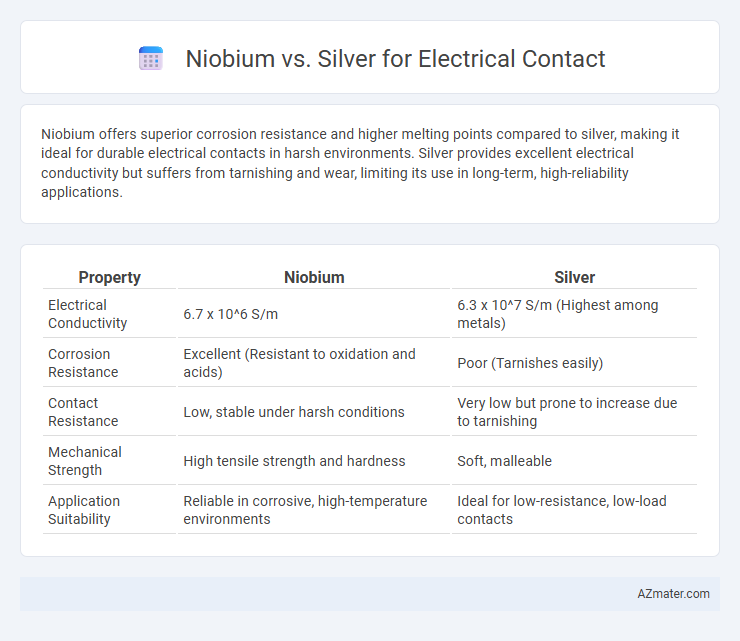Niobium offers superior corrosion resistance and higher melting points compared to silver, making it ideal for durable electrical contacts in harsh environments. Silver provides excellent electrical conductivity but suffers from tarnishing and wear, limiting its use in long-term, high-reliability applications.
Table of Comparison
| Property | Niobium | Silver |
|---|---|---|
| Electrical Conductivity | 6.7 x 10^6 S/m | 6.3 x 10^7 S/m (Highest among metals) |
| Corrosion Resistance | Excellent (Resistant to oxidation and acids) | Poor (Tarnishes easily) |
| Contact Resistance | Low, stable under harsh conditions | Very low but prone to increase due to tarnishing |
| Mechanical Strength | High tensile strength and hardness | Soft, malleable |
| Application Suitability | Reliable in corrosive, high-temperature environments | Ideal for low-resistance, low-load contacts |
Introduction to Electrical Contact Materials
Niobium and silver are prominent materials used in electrical contact applications due to their unique properties affecting conductivity, corrosion resistance, and durability. Silver offers exceptional electrical conductivity and low contact resistance, making it ideal for high-performance switches and connectors, while niobium provides enhanced wear resistance and oxidation stability under harsh conditions. The choice between niobium and silver depends on balancing electrical efficiency with mechanical endurance and environmental factors in contact material selection.
Overview of Niobium and Silver
Niobium is a refractory metal known for its excellent corrosion resistance, high melting point of 2,468degC, and good electrical conductivity, making it suitable for specialized electrical contacts in harsh environments. Silver, with the highest electrical conductivity among metals at 63x10^6 S/m and excellent thermal conductivity, is widely used for electrical contacts to ensure minimal resistance and efficient current flow. While silver offers superior conductivity, niobium's strength and resistance to oxidation provide advantages in applications requiring durability and reliability under extreme conditions.
Electrical Conductivity: Niobium vs. Silver
Silver exhibits superior electrical conductivity at approximately 63 x 10^6 S/m, making it the benchmark material for electrical contacts. Niobium, with an electrical conductivity of about 6.7 x 10^6 S/m, is significantly less conductive but offers better corrosion resistance and mechanical strength. Choosing between niobium and silver for electrical contacts depends on the balance between conductivity requirements and environmental durability.
Corrosion Resistance Comparison
Niobium exhibits superior corrosion resistance compared to silver in electrical contacts, especially in harsh environments with oxidizing agents or acidic conditions. While silver offers excellent electrical conductivity, it readily tarnishes and forms silver sulfide, leading to increased contact resistance over time. Niobium's robust oxide layer provides stable protection against oxidation and corrosion, ensuring longer-lasting and more reliable electrical connections.
Mechanical Strength and Durability
Niobium exhibits superior mechanical strength compared to silver, making it more resistant to deformation and wear in electrical contacts. Silver, while highly conductive, is softer and prone to abrasion and contact degradation over time. The enhanced durability of niobium results in longer-lasting electrical connections, especially in high-stress or high-vibration environments.
Thermal Conductivity Considerations
Niobium exhibits significantly lower thermal conductivity compared to silver, which directly affects its performance in electrical contacts by limiting heat dissipation during high current flow. Silver, known for its superior thermal conductivity of approximately 429 W/m*K at room temperature, efficiently reduces contact temperature rise, enhancing reliability and longevity. In applications where rapid heat removal and minimal thermal resistance are critical, silver's thermal conductivity advantage makes it the preferred material over niobium.
Cost and Availability
Niobium offers a cost advantage over silver due to its lower price per kilogram and greater abundance in the Earth's crust, reducing material expenses for electrical contacts. Silver, while highly conductive, is significantly more expensive and subject to market volatility, affecting long-term cost predictability and supply stability. Availability of niobium is supported by several large mining operations, ensuring consistent supply, whereas silver's demand in various industries can lead to periodic shortages and price fluctuations.
Applications in Electrical Engineering
Niobium offers superior corrosion resistance and higher melting point compared to silver, making it ideal for electrical contacts in harsh environments and high-temperature applications such as aerospace and power generation. Silver provides excellent electrical conductivity and lower contact resistance, which is preferred for precision electronics and low-voltage switching devices. Electrical engineers select niobium for durability in extreme conditions, while silver is favored for optimal conductivity in commercial and industrial electrical contacts.
Environmental Impact and Sustainability
Niobium exhibits superior corrosion resistance and durability compared to silver, leading to longer-lasting electrical contacts and reduced resource consumption over time. Silver mining involves significant environmental challenges, including habitat disruption and high energy use, whereas niobium extraction tends to have a lower ecological footprint due to more efficient processing techniques. The recyclability of niobium enhances its sustainability profile by minimizing waste and supporting circular economy practices in electronic components.
Choosing the Right Material for Electrical Contacts
Niobium offers exceptional corrosion resistance and high melting point, making it ideal for electrical contacts exposed to harsh environments or high temperatures. Silver provides superior electrical conductivity and low contact resistance, ensuring efficient current flow in everyday applications but tends to tarnish and degrade over time. Selecting between niobium and silver depends on balancing conductivity requirements with durability, environmental conditions, and maintenance considerations for optimal electrical contact performance.

Infographic: Niobium vs Silver for Electrical Contact
 azmater.com
azmater.com